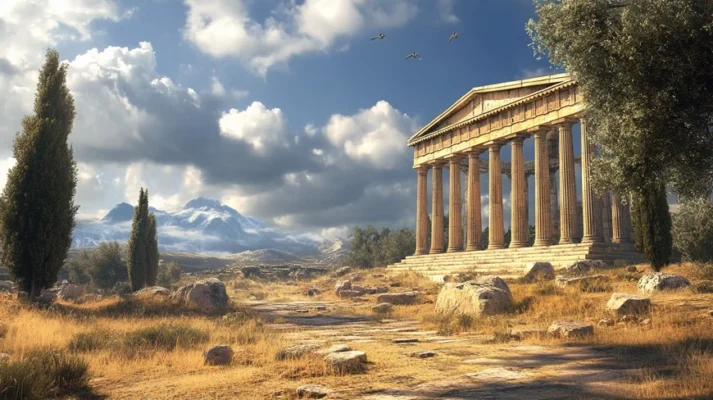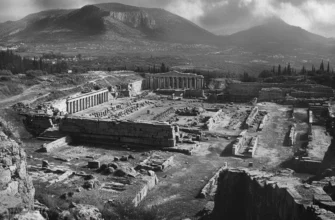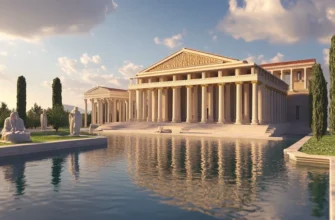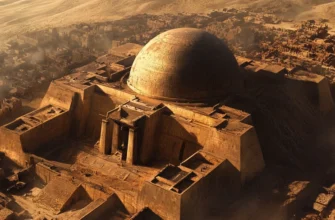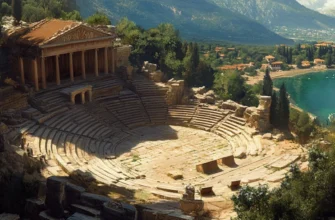Ephyra is one of the lesser-known but important cities of ancient Greece, located in the southwestern Peloponnese. The city became part of Greek civilization during the classical period, particularly during the heyday of Greek culture.
Founded in the early ancient period, Ephyra developed rapidly thanks to its strategic location and the growth of trade. The city became an important economic and cultural center, actively interacting with neighboring states.
Archaeological excavations in the territory of Ephyra have uncovered numerous remains of ancient buildings, temples, and other architectural monuments th Ephyra at testify to the high culture of this city. Among the finds, the remains of temples dedicated to the gods of Olympus, as well as numerous sculptures and household items, are particularly noteworthy.at testify to the high culture of this city. Among the finds, the remains of temples dedicated to the gods of Olympus, as well as numerous sculptures and household items, are particularly noteworthy.
Ephyra was also important in a political context, influencing the development of the Peloponnese and other regions of Greece. However, the city fell into decline, and over time its role in the Greek world diminished.
Today, the remains of Ephyra are an important site for archaeologists and tourists, as the city left behind a rich heritage that provides insight into the culture and history of ancient Greece.
- History of the city of Ephyra
- Foundation and early years
- The rise and fall of Ephyra
- Geographical location and archaeological finds
- Archaeological excavations and important monuments
- Culture and social structure of Ephesus
- Religion and temples
- The influence of religion on social structure
- Political structure and influence on neighboring states
- Art, science, and education
- Art in Ephyra
- Education in Ephyra
- Decline and legacy of Ephyra
- The legacy of Ephyra
- Archaeological finds and their significance
- Conclusion
History of the city of Ephyra
Ephyra was one of the important cities of ancient Greece, located in the southwestern Peloponnese.
The city emerged in the early ancient period, when many Greek cities were just beginning to form their political and cultural characteristics. Its strategic location facilitated the development of trade and military ties with other Greek states. Already in its early years, the city became an important economic and political center.
During the classical period, in the 5th-4th centuries BC, Ephyra experienced a heyday. It was a time of flourishing trade, as well as the development of architecture and art. The city actively interacted with other Greek city-states and even participated in military campaigns, which contributed to its development. Archaeological excavations have uncovered numerous temples, theaters, and other monumental buildings that testify to the high level of cultural development of Ephyra.
However, despite its successes, the city did not escape decline. The reasons for the decline were varied, ranging from internal political conflicts to the intervention of other states.
Subsequently, changes in the economic situation and the redirection of trade routes led to a decline in the city’s importance. By the end of the classical period, Ephesus had lost its former importance and was gradually abandoned. Despite its decline, the legacy of Ephesus remains an important part of the history of ancient Greece.
Archaeological excavations in the city help to study the culture and daily life of its inhabitants, and the artifacts found allow us to better understand the role of Ephyra in the overall context of Greek civilization. Today, the remains of the city are an important site for research and tourist visits.
Foundation and early years
The foundation of Ephyra took place in the early ancient period, when many Greek cities began to establish themselves as important commercial and political centers. The city was located in a strategic location in the southwestern Peloponnese, which facilitated the development of trade and the establishment of ties with neighboring Greek states.
The exact date of the founding of Ephyra is unknown, but it probably occurred during the early Greek civilization, when numerous settlements were emerging in the region.
At that time, Ephyra was a small but important center that began to develop thanks to its convenient geographical location, which allowed the city to control important trade routes. The city actively interacted with other Greek cities and benefited from natural resources such as fertile land and water resources, which allowed it to gradually strengthen its economy.
The early years of Ephyra were a period of stable development. The city is repeatedly mentioned in various historical sources as part of a large Greek cultural and political network. Its formation was part of the general process of development of Greek civilization, which was gaining momentum at that time, and Ephyra was becoming increasingly important in the region.
Throughout its history, Ephyra experienced a series of important events that were decisive for its development. During the city’s heyday, in the 5th-4th centuries BC, Ephyra was an important economic and cultural center and actively interacted with other Greek cities.
One of the key events was Ephyra’s participation in the military campaigns of that time. The city was located in a strategically important region, which allowed it to participate in military affairs and political alliances. Ephyra was part of various coalitions that could influence the balance of power in the Peloponnese.
Thanks to its location, the city also became an important trade hub, allowing it to prosper through the development of foreign and domestic trade. Ephyra was also known for its architectural achievements.
The city had numerous temples, theaters, as well as public and administrative buildings, which testify to the high level of development of local culture and organization. One of the most significant aspects of cultural development was the religious component of Ephyra’s life, with numerous temples dedicated to the Olympic gods, in particular Athena and Zeus.
The political development of Ephyra was accompanied by changes in governance as the city sought to maintain its autonomy in the complex political environment of the Greek city-states. Interaction with other major powers, such as Sparta, Athens, and even Macedonia, was also important for the growth of Ephyra.
With the development of Ephyra, its role as a cultural and political center gradually grew, but by the 4th century BC, signs of decline began to appear, linked to economic difficulties and political conflicts. These events were harbingers of future decline, although long after that, the city remained an important site of archaeological research and cultural heritage.
The rise and fall of Ephyra
Ephyra experienced a period of prosperity during the classical era, when the city became an important economic, cultural, and political center in the southwestern Peloponnese. Thanks to its strategic location, Ephyra actively interacted with other Greek cities, including Sparta, Athens, and Corinth. The trade routes that passed through the city contributed to the prosperity of its economy. During this period, Ephyra was an important center of trade, crafts, and religious festivals, which attracted numerous visitors.
The city’s architecture bears witness to its heyday. Magnificent temples, theaters, and public buildings were built, reflecting a high level of culture and organization. Religious rituals associated with the worship of the Olympian gods were of great importance to the inhabitants of Ephyra. The city became a venue for important religious festivals, which contributed to the development of cultural ties with other cities in Greece.
However, this period of prosperity did not last long. By the 4th century BC, Ephyra began to experience the first signs of decline. There were several reasons for this: internal political conflicts, economic difficulties, and military defeats. Changes in economic and trade routes, as well as growing competition from other city-states, led to a weakening of its position. In addition, the intervention of the great powers of the time, such as Sparta and Macedonia, weakened Ephyra’s independence.
The decline of the city continued gradually, and over time its importance in the political and economic life of Greece diminished. More and more people began to leave the city, and only archaeological remains remained in its place. By the end of antiquity, Ephyra was practically abandoned, and since then its role in the history of Greece has significantly diminished.
Today, the remains of Ephyra are an important site for archaeologists and tourists studying the heritage of ancient Greece. Although the city has long ceased to exist, its cultural and architectural heritage continues to impress researchers and remind us of the greatness of ancient civilization.
Geographical location and archaeological finds
Ephyra was located in the southwestern Peloponnese, in an area that now belongs to modern Greece.
The city was strategically located near important trade routes, which ensured its economic development and interaction with other Greek cities such as Sparta, Corinth, and Athens. Its geographical position allowed Ephyra to control a significant part of the trade routes between different regions of Greece, which was an important factor in its prosperity during the classical period.
The city was located on the coast, which also gave it access to maritime trade, which was the main source of wealth for many Greek city-states. Thanks to this location, Ephyra was able to develop as an important economic center, particularly through the development of crafts, agriculture, and the processing of natural resources.
Archaeological excavations in the area of Ephyra have uncovered numerous important finds that provide insight into the culture and daily life of the city. One of the most significant finds is the remains of temples dedicated to the main gods of Olympus, in particular Zeus and Athena. These temples testify to the high religiousness of the population and the importance of religious rituals in the life of the city. In addition, archaeologists have found monumental buildings, theaters, and public buildings, which testify to a developed architectural culture.
An important aspect of the archaeological excavations is the numerous sculptures, household items, and artistic works that provide a better understanding of the level of art development in Ephyra. In particular, finds of pottery and metalwork testify to a high level of craftsmanship and trade. Coins and other economic artifacts confirm the city’s active participation in the trade networks of the time.
Thus, archaeological excavations in Ephraim allow us not only to study material culture, but also to reconstruct the social, religious, and political life of the ancient city. The remains of these finds help researchers reconstruct important aspects of the daily life of the inhabitants of Ephyra and understand how this city fit into the broader context of Greek civilization.
Archaeological excavations and important monuments
Archaeological excavations in Ephesus have become an important stage in the study of the ancient city and its heritage. The discovery of numerous monuments allows us today to understand not only the everyday life of the inhabitants of Ephesus, but also the role of this city in the cultural and religious life of Greece.
One of the most important archaeological finds is the remains of temples dedicated to the main gods of Olympus. In particular, a temple dedicated to Zeus was found, which is evidence of the religious significance of the city. These temples were not only places of worship but also important centers of cultural and social events, such as the celebration of religious holidays that united the community.
The remains of a theater were also an important find, testifying to the development of theatrical art in Ephyra. As in other Greek cities, the theater was an important element of cultural life, hosting dramatic performances, religious ceremonies, and public gatherings. These excavations provide insight into how the theater played a role in educating citizens and supporting political and cultural traditions.
Other significant finds include the remains of public and administrative buildings, indicating a well-organized city administration. Architectural details such as columns and fragments of monumental structures help to recreate the appearance of the town in its heyday. Many of these buildings were constructed in the classical Greek architectural tradition, demonstrating the high level of building skills in Ephyra.
Numerous household items, ceramics, coins, and statuettes are also important archaeological finds. These artifacts provide a better understanding of everyday life in the city. In particular, the coins found indicate Ephyra’s economic ties with other cities in Greece and even with neighboring cultures. Pottery and metalwork show the level of craftsmanship, as well as the tastes and artistic preferences of the city’s inhabitants.
Excavations in Ephyra continue today, and each new discovery provides more insight into this important center of ancient Greece. The city’s archaeological sites not only help to reconstruct its history, but also open new pages in the understanding of Greek culture, religion, and social organization.
Culture and social structure of Ephesus
The culture and social structure of Ephesus were closely linked to the traditions of classical Greece, reflecting the main elements of Greek civilization, such as religion, art, economy, and politics. Although the city was not one of the largest or most famous centers of Greece, its culture and social organization testify to a high level of development within the region.
Culture of Ephyra
The culture of Ephyra was multifaceted and encompassed religious rituals, art, architecture, and literature. As in most Greek cities, religion played a central role in the life of the community. The most important were the temples dedicated to the main Olympic gods, such as Zeus and Athena. These religious rituals not only promoted community unity but also attracted numerous pilgrimages and celebrations, which strengthened social ties and provided economic benefits through the development of tourism.
Art in Ephesus included not only sculpture and painting, but also theatrical performances. An important element of cultural life was theater, which was performed in large theater venues where dramatic performances related to religious holidays and public events were staged. In addition, the city was famous for its ceramics and crafts, which were important not only for domestic consumption but also for export.
Social structure of Ephesus
The social structure of Ephesus was typical of Greek city-states, where society was divided into several social classes. At the top were free citizens who had political rights and actively participated in the life of the city. These citizens were engaged in agriculture, crafts, or military service and enjoyed certain rights, such as participation in popular assemblies and voting on political issues.
Lower in the social hierarchy were the metics (foreigners), who did not have citizenship rights but could live in the city, conduct business, and pay taxes. They were often merchants or craftsmen who played an important role in the economic life of the city, although they could not participate in political processes.
Slaves made up the lowest class of the population and, as a rule, had no rights. They worked on the land or in the households of their owners, performing hard physical labor. The system of slavery was an important part of the city’s economic structure, although the number of slaves was not as large as in larger Greek cities.
An important aspect of the social structure of Ephyra was the role of women, who usually did not have citizenship rights and were limited to domestic activities, but took an active part in religious ceremonies and some public events. Most women were responsible for raising children and managing the household.
The role of politics and public life
Ephra was part of a wider political network, and its social structure also reflected the influence of larger cities such as Sparta and Athens. The city enjoyed a certain degree of autonomy but also interacted with other cities in the form of political alliances and economic relations. However, the political structure of Ephyra was less developed than that of the largest Greek cities, such as Athens or Sparta, and this probably also contributed to its gradual decline.
The social and cultural traditions of Ephyra, its religious life, and the organization of public festivals helped to preserve its social structure for many centuries, although during its decline, the city was unable to regain its former glory. Nevertheless, thanks to archaeological finds, we are able to study and evaluate the level of cultural development and social organization of this ancient community.
Religion and temples
Religion was one of the main components of life in ancient Greece, and Ephyra was no exception. As in other city-states, religious beliefs in Ephyra determined not only the daily life of its inhabitants, but also cultural, political, and social processes.
Religious practice in Ephyra, as in most Greek cities, was associated with the worship of the Olympic gods and other deities of the Greek pantheon.
Religious practices
The main feature of religion in Ephesus was polytheism. The inhabitants of the city worshipped numerous gods and goddesses, among whom Zeus, Athena, Artemis, and other Olympian gods were the most important. Religious rituals often took place in temples, at festive gatherings, and during religious festivals. They were an important part of social life, helping to strengthen community unity and restore ties with the gods.
Temples were built in Ephesus to celebrate religious holidays, serving not only a religious but also a cultural role. Temples were places not only for prayer and sacrifice but also for religious festivals, sporting events, and other public gatherings. They served as a symbol of interaction between humans and gods, as well as a reminder of the importance of divine protection for the prosperity of the city.
Temples of Ephesus
Archaeological excavations in Ephesus have uncovered several important temples dedicated to the main gods of Olympus. One of the most famous is the temple dedicated to Zeus, which was the center of the city’s religious life. Zeus was considered not only the god of the sky and thunder, but also the patron of justice and power, so his cult was of great importance to the inhabitants of Ephraim. The temple of Zeus was probably large and architecturally magnificent, reflecting the importance of the god to the city’s inhabitants.
In addition to the temple of Zeus, There was also a temple dedicated to Athena, the goddess of wisdom and strategic warfare. Athena was considered the patroness of cities and culture, and her temples often became centers of scientific and cultural discussion. Her cult was popular among Greek cities, so in Ephyra, as in other places, the cult of Athena was of great importance for the political and cultural organization of the community.
There was also probably a temple to Artemis, goddess of hunting and wildlife, who was popular among Greek cities located near forest and mountain areas. The existence of a temple to Artemis in Ephyra emphasizes the importance of this god to a city that maintained ties with nature and provided vital resources for its economy.
Sacrifices and religious holidays
Sacrifices were an important part of religious practices in Ephyra. The city’s residents offered sacrifices to the gods in the form of animals (usually pigs, sheep, and birds) or various gifts, such as food, wine, and olive oil.
These rituals were intended to appease the gods, ensure the well-being of the city, and guarantee harvests and peace in the state.
Religious festivals held in Ephraim included musical and theatrical performances, sports competitions, and processions. They became important cultural events where locals could show their devotion to the gods, as well as get a chance to express themselves culturally and strengthen social ties.
The influence of religion on social structure
Religion also had a big impact on the social organization of Ephesus. Temples often became centers not only of religious practice but also of social events where certain political, economic, and cultural relationships were determined. Priests, who had significant status in society, played the role of intermediaries between people and gods and also influenced important decisions in the city.
Overall, religion in Ephesus was an integral part of the cultural and social life of the city. Temples, religious holidays, and rituals promoted community unity and strengthened the sense of belonging to a larger Greek civilization that extended beyond the city limits.
Political structure and influence on neighboring states
The political structure of Ephesus was typical of many Greek city-states (polis) of that time. It included a system of self-government in which citizens actively participated in important decisions through popular assemblies, and also had its own governing bodies, such as magistrates and councils. However, despite a certain degree of political autonomy, Ephesus’ political role within the broader Greek political landscape was limited.
Political structure of Ephesus
Ephesus, like many other Greek city-states, had a democratic form of government, where important political decisions were made at assemblies of citizens who had the right to vote. However, given the size and importance of the city, its political system was less developed and organized than in larger cities such as Athens or Sparta.
At the center of Ephyra’s political structure was a citizens’ assembly consisting of free men who had civil rights. The assembly had the power to make decisions on key issues of city life, from legislation to the election of magistrates. The magistrates performed administrative, judicial, and military functions, as well as overseeing the city’s economic activities.
However, unlike the large Greek city-states, Ephyra did not have strong democratic institutions, and the city probably had more limited political participation, concentrated in the hands of the aristocracy and more influential families. In any case, the political system was geared toward maintaining order and a certain level of social harmony, which was important for the city’s prosperity in the face of constant external threats.
Ephyra’s influence on neighboring states
Although Ephyra was not a large state and did not achieve the political weight of giants such as Athens or Sparta, it played an important role in its region due to its strategic location in the southwestern Peloponnese.
Ephyra had a significant influence on neighboring states, particularly Sparta, Corinth, and Messenia.
- Interaction with Sparta:
Ephyra maintained close ties with Sparta, particularly through trade and military alliances. Sparta was a powerful military state, and due to its strategic importance, Ephyra was part of its sphere of influence. The Spartans could use Ephyra as an important economic and military outpost to control the southwestern Peloponnese.
- Relations with Corinth:
Corinth, on the other hand, was an important trading partner of Ephyra. As one of the richest city-states in Greece, Corinth had great economic influence in the region. The city traded actively with Ephyra, and this economic connection strengthened the position of both states in the Mediterranean market. Also, as part of the ancient Greek political map, Corinth could influence Ephyra’s decisions on various foreign policy initiatives.
- Interaction with Messenia:
Ephyra was in a state of tension with Messenia, a neighboring territory that was constantly fighting for autonomy from Sparta. Although direct military conflicts were few, Ephyra had a geopolitical interest in maintaining stability and balance of power in its region, maintaining certain ties with other cities and even sometimes entering into alliances to counter Spartan hegemony.
Despite its relatively minor political weight, Ephyra participated in the major political processes of the time, particularly during the Peloponnesian War, when many Greek city-states entered into complex alliances and conflicts. At that time, its strategic location in the west of the Peloponnese was important both for military operations and for controlling economic flows.
Although Ephyra did not become a hegemon among the Greek city-states, its political structure and interaction with other states were important for regional politics. Its influence on neighboring states, particularly through trade, military, and cultural ties, testifies to the importance of this city in the context of ancient Greek civilization.
Art, science, and education
Art, science, and education in Ephraea, although not as advanced as in the great cultural centers of Greece, such as Athens, were nevertheless important components of the cultural life of this ancient city. Ephra, like most cities of that time, was closely linked to the development of art, as well as to the support of education and scientific achievements, although it had its own specific characteristics due to its geographical location and political conditions.
Art in Ephyra
Art in Ephyra developed within the context of pan-Greek traditions, but also had its own regional characteristics. As in other cities in Greece, the main art forms were architecture, sculpture, painting, and ceramics.
- Architecture:
The city was known for its architecture, particularly its religious buildings, such as temples dedicated to the main deities of Olympus. As in other Greek cities, the temples were characterized by a classical style, with the use of columns and other architectural elements that became iconic for that period. For example, the temple of Zeus in Ephyra was of great importance for religious and cultural life, and the architecture of this temple reflected the aesthetic achievements of the time.
- Sculpture and painting:
Sculpture in Ephyra also developed under the influence of classical Greek traditions. The remains of statues of gods, heroes, and figures from mythology found during archaeological excavations testify to the high quality of local craftsmen.
They created not only religious statues but also decorative elements for temples and public buildings. Painting, especially on ceramics, was an important part of everyday life in Ephraim. The works of local potters were often decorated with drawings depicting mythological scenes as well as the life of the city.
Science in Ephraim
Although Ephraim was not known for its great scientific achievements, such as Alexandria or Athens, there was still some scientific activity in the city. An important aspect of scientific activity was geography and astronomy, as the local inhabitants were involved in maritime trade and the study of natural phenomena.
These scientific fields were closely linked to religion and the city, and helped in the planning of festivals and astronomical rituals.
Also, as in other cities of Greece, some local philosophers and scientists were probably engaged in the study of ethics, politics, and other social aspects. At the same time, compared to other major centers of science, such as Athens or Miletus, science in Ephyra remained at a lower level, and therefore much of the knowledge and achievements were based on practical experience and passed down from generation to generation.
Education in Ephyra
Education in Ephyra, as in other Greek city-states, was an important part of culture. Educational practices mainly focused on preparing young people for participation in public life and developing personal skills in the arts, sports, and religious duties.
- Primary education:
As in other Greek cities, education for children was mostly provided at home or in small groups. The curriculum included language, literature, music, and basic mathematics and astronomy. Rhetoric and moral lessons were also important subjects, designed to prepare citizens for participation in the political life of the city.
- Physical education:
Sports played an important role in education in Ephesus, particularly in the form of physical competitions such as running, wrestling, and pankration. Educational programs included training in physical disciplines, which were also an important part of public and religious festivals. Participation in sports competitions contributed to the development of not only physical strength but also character and civic responsibility.
- Higher education and philosophy:
Higher education in Ephesus was less developed than in other major Greek cities, where there were academies and philosophical schools. However, there may have been individual teachers and philosophers in the city who passed on their knowledge to a limited circle of students. These teachers probably focused on ethics, politics, and other important aspects of social life.
Art, science, and education were important components of Ephyra’s cultural life. Although the city did not achieve such great achievements as other Greek city-states, its artistic and scientific activities contributed to the development of Pan-Hellenic culture. The development of art, particularly architecture and sculpture, science, and education, in turn, helped to preserve the traditions and values of this ancient city for posterity.
Decline and legacy of Ephyra
The decline of Ephyra, like that of many other Greek city-states, was the result of a number of internal and external factors that undermined its political and economic stability. Although the exact causes of the decline cannot always be determined with certainty, historians point to certain key moments that were turning points in the city’s history.
One of the main reasons for the decline of Ephyra was the intensification of military and political disputes between Greek cities, especially during the Peloponnesian War (431–404 BC). During this period, competition between Athens and Sparta, as well as internal conflicts in the region, weakened the economic and military potential of Ephyra.
Despite its strategic location in the southwestern Peloponnese, Ephyra was unable to maintain its autonomy and influence among the major Greek city-states. The city became part of larger political entities and alliances, particularly through alliances with other Greek cities and pressure from Sparta. As a result of these changes, Ephyra gradually lost its economic and political importance.
Another important reason for its decline was the decline in trade and maritime communications, which were important sources of income for Ephyra. The decline in economic activity and the transfer of major trade routes to other areas of the Mediterranean led to the weakening of the city.
After the fall of classical Greek civilization and the decline of city-states during the Hellenistic Wars, Ephyra fell under the rule of other great empires. The last mentions of the city date back to the Hellenistic period, when its territory was partially absorbed by new political entities, such as the states that emerged after the conquests of Alexander the Great.
By the end of the 3rd century BC, Ephyra had lost its political significance and its territory came under Roman control.
The legacy of Ephyra
Although the city no longer existed as an independent political entity, its legacy survived for centuries and influenced the further development of Greek and Roman cultures.
The religious, cultural, and artistic achievements of Ephyra were important for Greek civilization as a whole.
- Architectural heritage:
One of the most significant aspects of Ephyra’s heritage is its architecture, particularly its numerous temples, which reflect the high level of Greek architecture at the time. The ruins of the Temple of Zeus in Ephesus, in particular, remain an important archaeological site and a testament to the city’s former glory. The temple architecture and sculptures found during excavations have become part of the world’s cultural heritage, helping to preserve the historical memory of this city for future generations.
- Cultural influence:
The culture of Ephyra also became part of the great Greek tradition. The art, literature, and philosophy that developed in the city inspired other Greek cities and, later, Roman culture.
Of particular importance were the religious ceremonies held in the temples and the artistic achievements in sculpture and ceramics. They highlighted the importance of the connection between religion and art, which became the basis for the development of ancient culture.
- Contribution to science and education:
Ephraim also made a significant contribution to the development of education and science. Although the city was not known for its great philosophers, like Athens, its scientific achievements, particularly in geography and astronomy, were important for the development of knowledge at that time. The educational practices used in Ephesus became the basis for educational programs in other cities.
Archaeological finds and their significance
Archaeological excavations carried out in Ephyra allow modern researchers to reconstruct the image of the city, its architecture, culture, and social structure. The city left behind numerous artifacts, from pottery and coins to temple frescoes and statues.
Also important are the remains of Greek theater buildings, which indicate the importance of theater and performances in the cultural life of the city.
The heritage of Ephesus today helps to study not only the history of this particular city, but also Greek culture in general. Excavations in the ancient city are an important source of information for archaeologists, historians, and cultural researchers, helping to understand how one of the many Greek city-states functioned during the Classical and Hellenistic periods.
The decline of Ephyra was inevitable in the context of political and military changes in the Mediterranean, but its legacy left a significant mark on the culture and history of Ancient Greece. The architecture, art, science, and education of Ephyra became part of the great ancient heritage that influenced the subsequent stages of European civilization.
Conclusion
Although not one of the largest or most famous Greek city-states, Ephyra left a significant mark on the cultural and historical heritage of Ancient Greece. The city was an important religious, cultural, and economic center, as well as part of the great Greek civilization that influenced the development of Europe and the world as a whole.
Ephyra was an important religious center, thanks in particular to the magnificent temple of Zeus and other architectural heritage that reflected Greek religious beliefs. The temple architecture and sculpture of the city became important elements of Greek culture and had a great influence on the further development of art in other city-states. The city also left behind numerous architectural monuments that are evidence of the high level of art that was achieved during the classical period of Greece. The religious and public buildings of Ephesus became symbols of Greek aesthetics and engineering skill.
The knowledge developed in Ephesus in the fields of geography, astronomy, and education also played an important role in the development of ancient science and education. Although the city did not become a center of philosophy, its scientific achievements and practices were significant for the educational traditions that were preserved and spread to other parts of the Greek world. Ephyra’s political activity, although limited compared to larger states, demonstrated a form of government and interaction with neighboring states typical of Greek city-states. The city left an important political mark on its region, forming ties and alliances with other states, notably Sparta and Corinth.
Overall, although Ephyra experienced decline, its importance for the development of Greek civilization and its cultural heritage left a deep mark on the history of Greece and the world. Excavations of archaeological sites preserved to this day help modern researchers better understand life, art, and politics in ancient times. The legacy of Ephyra, as part of the great Greek culture, will long remain an important element of world history.
